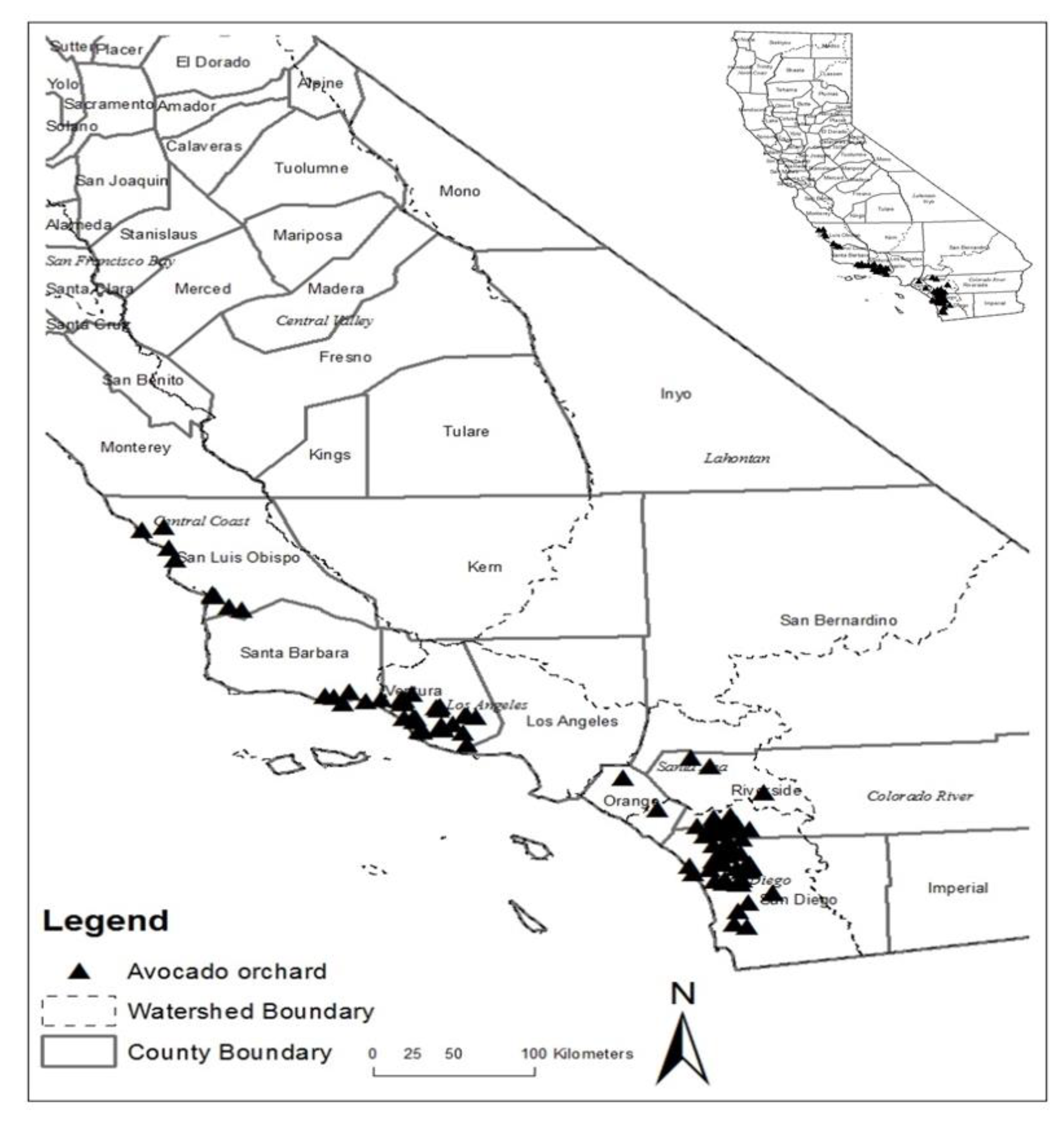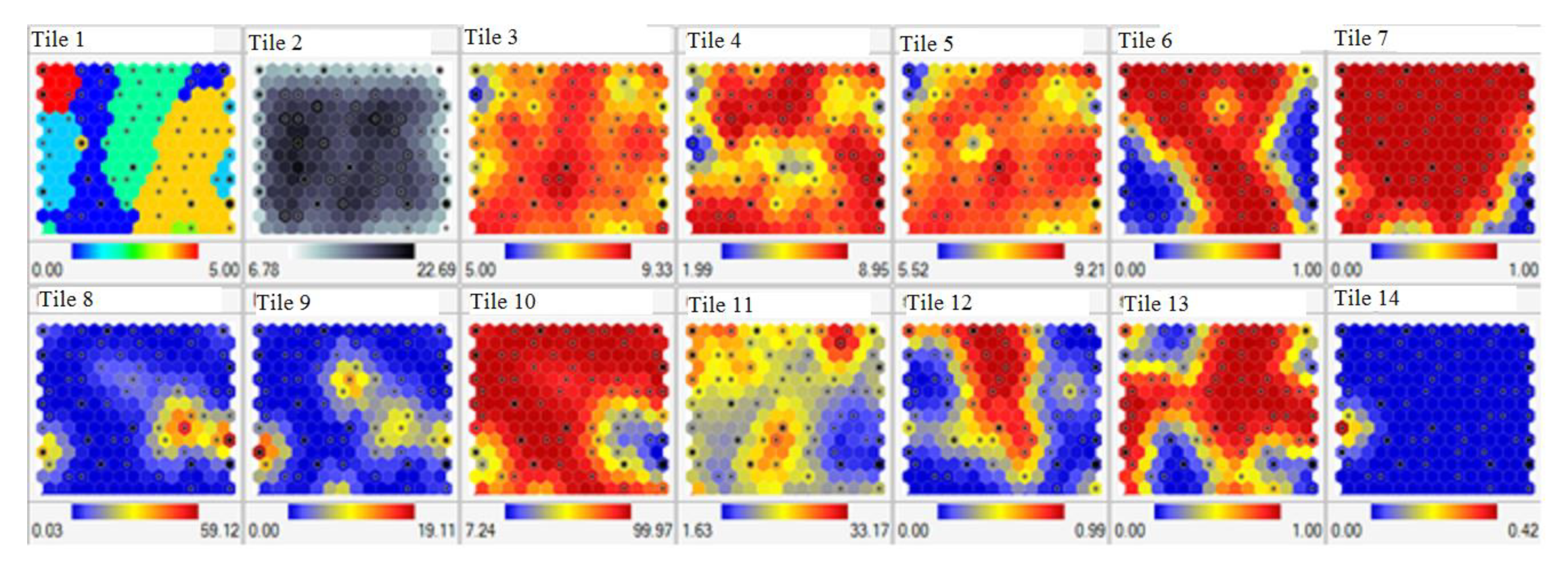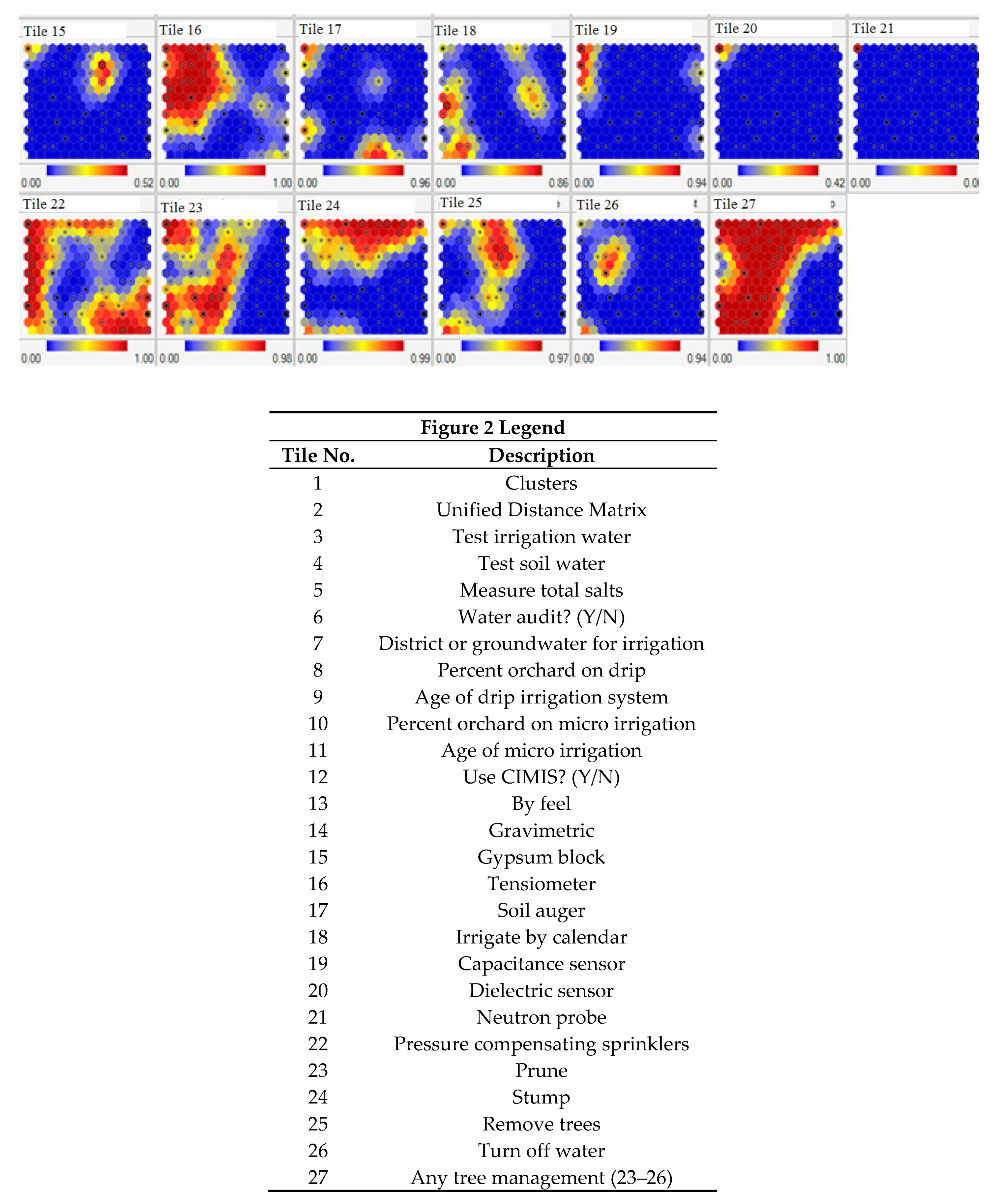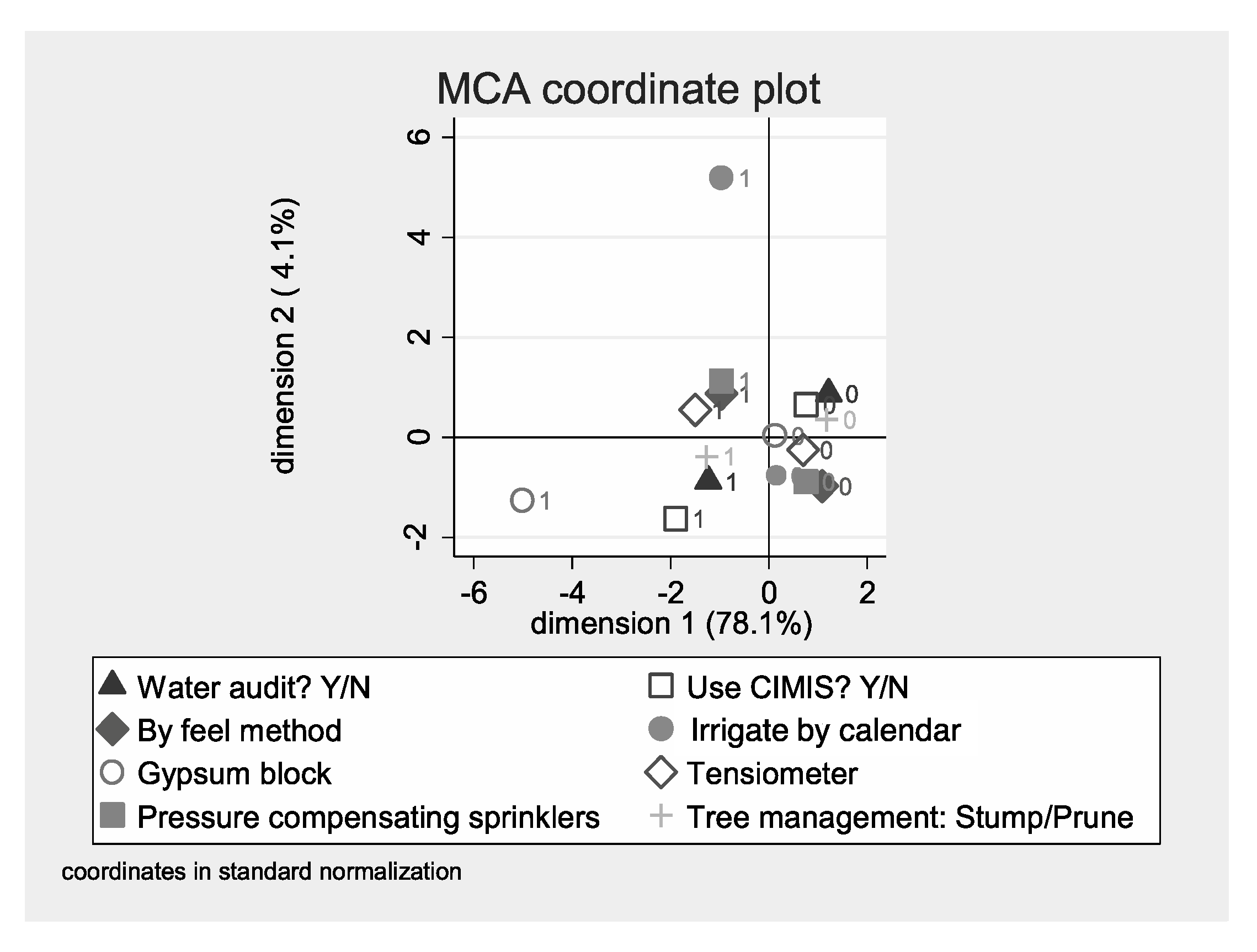Dealing with Water Scarcity and Salinity: Adoption of Water Efficient Technologies and Management Practices by California Avocado Growers
Abstract
1. Introduction
2. Methodology
2.1. Analytical Framework
2.2. Analytical Model
3. Data and Variable Construction
3.1. Setting the Bundles
3.2. Bundle Zero Growers
3.3. Development of other Bundles
3.4. The Bundles in the Dataset
3.5. Explanatory Variables
3.6. Empirical Models
4. Results
4.1. Descriptive Statistics Results
4.2. Regression Results
5. Discussion of Main Results
6. Conclusions and Policy Implications
Author Contributions
Funding
Conflicts of Interest
Appendix A. Water Efficient Technologies and Management Practices Used by California Avocado Growers
Appendix A.1. Soil Moisture Monitoring
Appendix A.2. Meteorological Data to Manage Water Applications
Appendix A.3. Canopy Reduction
Appendix A.4. Water Audits
Appendix A.5. Pressure Compensating Sprinkler
Appendix A.6. Tensiometer
Appendix A.7. Gypsum Blocks
Appendix B. The Survey Instrument—Adoption of Water Technologies and Management Practices by California Avocado Growers
| High School | Some College | A.A./A.S. | B.A./B.S. | Ma/PhD | Other | |
| Education |
| Irrigation block acreage | Block shape | Slope None = 0% Low = 0–5% Med = 5–10 Mod = 10–15 Severe ≤ 15% | Soil texture: Sand Sandy loam Loam Clay loam Clay |
Square  | |||
Rectangular  | |||
Triangle  | |||
Irregular  | |||
| # of Trees | Variety and Rootstock | Avg. Age of Trees (yrs) | Avg. Height of Trees (ft) | Tree Spacing (ft) Ex. 20 × 20 | 1 = Mound(berm) or 2 = Native Terrain |
| Water District 1 | Water District 2 | |
| Water District Name | ||
| Acres of your orchard serviced (ac) | ||
| Annual water use for 2012 yr (ac/ft yr) | ||
| Avg. Cost of water per month ($/ac ft) |
| District Water | Ground Water (Well) | Recycled Water | Trucked in Water | Other | |
| % used for irrigation | |||||
| If known fill in: | |||||
| ECw (dS/m) | |||||
| TDS (ppm) | |||||
| Chloride (ppm) |
| Surface Drip | Micro Sprinklers | Other | |
| % of grove with this type of system | |||
| Age of system (yrs) |
| Fall | Winter | Spring | Summer | |
| Daily | ||||
| Weekly | ||||
| Bi-weekly | ||||
| Monthly | ||||
| Bi-monthly | ||||
| Other |
| 1.Unified: Operated by a single individual who performs all the tasks  | 2.Cooperative Market Organization: The simplest level of horizontal task specialization - the separation between workers and management |
3.Primary Hierarchy: Workers are distinguished from management as well as from each other. Two units: management and labor |  4. Functional Hierarchy: Similar to simple but managers are also organized according to tasks. Irrigation managers perform distinct tasks from those performed by the machine shop manager. |
5.Coopoerative Market hierarchy: Similar to Type 2, Workers and managers form specialized units producing unique crops for particular markets | 6.Market Hierarchy: Workers are organized by markets, clients and locations |
| Other: Please describe and draw diagram | |
| Type | % of Orchard Treated | #of Acres Treated |
| Selective Pruning | ||
| Stumping | ||
| Removal of trees | ||
| Turned water off | ||
| Other | ||
| None |
| Cooperative Extension | CAC | Online Sources | Journals/Books | Supplier/Agents/Labs | Growers | Other | |
| Weekly | |||||||
| Monthly | |||||||
| Bi-annually | |||||||
| Yearly | |||||||
| Other |
| Cooperative Extension | CAC | Online Sources | Journals/Books | Supplier/Agents/Labs | Growers | Other | |
| Fertilizer | |||||||
| Irrigation | |||||||
| Pest/disease | |||||||
| Harvest | |||||||
| Pollination | |||||||
| Water policy | |||||||
| Other |
| Rate Level of Importance 1–5 1 = Low 5 = High | |
| Cooperative extension | |
| CAC | |
| Online sources | |
| Journals/books | |
| Supplier/Agents/labs | |
| Growers | |
| Other |
| Fruit Size | Total Yield (lbs) for Entire Orchard |
| 24 | |
| 28 | |
| 32 | |
| 36 | |
| 40 | |
| 48 | |
| 60 | |
| 70 | |
| 84 | |
| 96 | |
| #2 | |
| culls |
References
- Boretti, A.; Rosa, L. Reassessing the projections of the World Water Development Report. NPJ Clean Water 2019, 2, 15. [Google Scholar] [CrossRef]
- Clifton, C.; Evans, R.; Hayes, S.; Hirji, R.; Puz, G.; Pizarro, C. Water and Climate Change: Impacts on Groundwater Resources and Adaptation Options. In BNWPP Water Working Notes 25; World Bank: Washington DC, USA, 2010. [Google Scholar]
- Food and Agricultural Organization (FAO). Water for Sustainable Food and Agriculture; A report produced for the G20 Presidency of Germany; FAO: Rome, Italy, 2017. [Google Scholar]
- UCCE and CAS (University of California Cooperative Extension, San Diego County, and The California Avocado Society). Avocado Production in California—A Cultural Handbook for Growers, 2nd ed.; Book One-Background Information; UCCE and CAS: San Diego, CA, USA, 2012. [Google Scholar]
- Fleischer, A.; Mendelsohn, R.; Dinar, A. Bundling agricultural technologies to adapt to climate change. Technol. Forecast. Soc. Chang. 2011, 78, 982–990. [Google Scholar] [CrossRef]
- Campbell, M.B.; Dinar, A. Farm organization and resource use. Agribusiness 1993, 9, 465–480. [Google Scholar] [CrossRef]
- Dinar, A.; Yaron, D. Adoption and Abandonment of Irrigation Technologies. Agric. Econ. 1992, 6, 315–332. [Google Scholar] [CrossRef]
- Feder, G.; Just, R.E.; Zilberman, D. Adoption of Agricultural Innovations in Developing-Countries—A Survey. Econ. Dev. Cult. Chang. 1985, 33, 255–298. [Google Scholar] [CrossRef]
- Feder, G.; Umali, D.L. The Adoption of Agricultural Innovations—A Review. Technol. Forecast. Soc. Chang. 1993, 43, 215–239. [Google Scholar] [CrossRef]
- Koundouri, P.; Nauges, C.; Tzouvelekas, V. Technology adoption under production uncertainty: Theory and application to irrigation technology. Am. J. Agric. Econ. 2006, 88, 657–670. [Google Scholar] [CrossRef]
- Salazar, C.; Rand, J. Production risk and adoption of irrigation technology: Evidence from small-scale farmers in Chile. Lat. Am. Econ. Rev. 2016, 25, 2. [Google Scholar] [CrossRef]
- Wang, J.; Mendelsohn, R.; Dinar, A.; Huang, J. How Chinese Farmers Change Crop Choice to Adapt to Climate Change. Clim. Chang. Econ. 2010, 1, 167–185. [Google Scholar] [CrossRef]
- Lambert, D.M.; Paudel, K.P.; Larson, J.A. Bundled adoption of precision agriculture technologies by cotton producers. J. Agric. Resour. Econ. 2015, 40, 325–345. [Google Scholar]
- Tey, Y.S.; Brindal, M. Factors influencing the adoption of precision agricultural technologies: A review for policy implications. Precis. Agric. 2012, 13, 713–730. [Google Scholar] [CrossRef]
- Sureshkumar, P.; Geetha, M.C.; Narayanan Kutty, C.; Pradeepkumar, T. Fertigation—The key component of precision farming. J. Trop. Agric. 2017, 54, 103–114. [Google Scholar]
- Kiggundu, N.; Migliaccio, K.W.; Schaffer, B.; Crane, J.H. Water Savings, Nutrient Leaching, and Fruit Yield in a Young Avocado Orchard as Affected by Irrigation and Nutrient Management. Irrig. Sci. 2012, 30, 275–286. [Google Scholar] [CrossRef]
- Boland, A.M.; Bewsell, D.; Kaine, G. Adoption of sustainable irrigation management practices by stone and pome fruit growers in the Goulburn/Murray Valleys, Australia. Irrig. Sci. 2006, 24, 137–145. [Google Scholar] [CrossRef]
- Pereira, L.S.; Oweis, T.; Zairi, A. Irrigation management under water scarcity. Agric. Water Manag. 2002, 57, 175–206. [Google Scholar] [CrossRef]
- Carmen, H.F. The Story Behind Avocados’ Rise to Prominance in the United States. Agric. Resour. Econ. Update 2019, 22, 9–11. [Google Scholar]
- UCCE and CAS (University of California Cooperative Extension, San Diego County, and The California Avocado Society). Avocado Production in California—A Cultural Handbook for Growers, 2nd ed.; Book Two—Cultural Care; UCCE and CAS: San Diego, CA, USA, 2012. [Google Scholar]
- USDA-Economic Research Service. Beginning Farmers and Age Distribution of Farmers. 2012. Available online: https://www.ers.usda.gov/topics/farm-economy/beginning-disadvantaged-farmers/beginning-farmers-and-age-distribution-of-farmers/ (accessed on 2 July 2019).
- Genius, M.; Koundouri, P.; Nauges, C.; Tzouvelekas, V. Information Transmission in Irrigation Technology Adoption and Diffusion: Social Learning, Extension Services, and Spatial Effects. Am. J. Agric. Econ. 2011, 96, 328–344. [Google Scholar] [CrossRef]
- Tiamiyu, S.; Akintola, J.; Rahji, M. Technology Adoption and Productivity Difference among Growers of New Rice for Africa in Savanna Zone of Nigeria. Tropicultura 2009, 27, 193–197. [Google Scholar]
- Robertson, M.J.; Llewellyn, R.S.; Mandel, R.; Lawes, R.; Bramley, R.G.V.; Swift, L.; Metz, N.; O’Callaghan, C. Adoption of variable rate fertiliser application in the Australian grains industry: Status, issues and prospects. Precis. Agric. 2012, 13, 181–199. [Google Scholar] [CrossRef]
- Yaron, D.; Dinar, A.; Voet, H. Innovation on Family Farms: The Case of the Nazareth Region in Israel. Am. J. Agric. Econ. 1992, 74, 361–370. [Google Scholar] [CrossRef]
- Bryant, C.R.; Smit, B.; Brklacich, M.; Johnston, T.R.; Smithers, J.; Chjotti, Q.; Singh, B. Adaptation in Canadian Agriculture to Climatic Variability and Change. Clim. Chang. 2000, 45, 181–201. [Google Scholar] [CrossRef]
- Beal, G.M.; Rogers, E.V.; Bohlen, J.M. Validity of the Concept of Stages in the Adoption Process. Rural Soc. 1957, 22, 166–168. [Google Scholar]
- Dorfman, J.H. Modeling multiple adoption decisions in a joint framework. Am. J. Agric. Econ. 1996, 78, 547–557. [Google Scholar] [CrossRef]
- Saxton, K.E.; Rawls, W.J. Soil water characteristic estimates by texture and organic matter for hydrologic solutions. Soil Sci. Soc. Am. J. 2006, 70, 1569–1578. [Google Scholar] [CrossRef]
- Farmer, D.; Sivapalan, M.; Jothityangkoon, C. Climate, soil, and vegetation controls upon the variability of water balance in temperate and semiarid landscapes: Downward approach to water balance analysis. Water Resour. Res. 2003, 39, 21. [Google Scholar] [CrossRef]
- Chatterjee, D.; Dinar, A.; González-Rivera, G. Impact of Agricultural Extension on Irrigated Agriculture Production and Water Use in California. J. Am. Soc. Farm Manag. Rural Appraisers 2019, 1, 65–84. [Google Scholar]
- Dinar, A.; Campbell, M.B.; Zilberman, D. Adoption of Improved Irrigation and Drainage Reduction Technologies Under Limiting Environmental Conditions. Environ. Resour. Econ. 1992, 2, 373–398. [Google Scholar] [CrossRef]
- California Avocado Commission. Available online: https://www.californiaavocado.com/ (accessed on 23 April 2020).
- Escalera, J.; Dinar, A.; Crowley, D. Adoption of Water-Related Technology and Management Practices by the California Avocado Industry. Agric. Resour. Econ. Update 2015, 18, 58. [Google Scholar]
- Kohonen, T. Essentials of the self-organizing map. Neural Netw. 2013, 37, 52–65. [Google Scholar] [CrossRef]
- Kohonen, T. Self-Organizing Maps; Springer: Berlin, Germany, 2001. [Google Scholar]
- Kalteh, A.M.; Hjorth, P.; Berndtsson, R. Review of the Self-organizing Map (SOM) Approach in Water Resources: Analysis, Modelling and Application. Environ. Model. Softw. 2008, 23, 835–845. [Google Scholar] [CrossRef]
- Reints, J.; Dinar, A.; Crowley, D. Dealing with Water Scarcity: California Avocado Growers Adopting Water Saving Technologies and Management Practices. UCR SPP Working Paper Series, June, 2017 WP# 02-17. Available online: https://spp.ucr.edu/sites/g/files/rcwecm1611/files/2019-09/082619_Dealing%20with%20Water%20Scarcity_FINAL.pdf (accessed on 25 April 2002).
- Faber, B. ( University of California, Cooperative Extension, San Diego, CA, USA). Personal Communications, 2015.
- Linting, M.; Meulan, J.J.; Groenen, P.J.F.; van der Kooij, A.J. Nonlinear Principal Components Analysis: Introduction and Application. Psychol. Methods 2007, 12, 336–358. [Google Scholar] [CrossRef] [PubMed]
- Jolliffe, I.T. Principal Component Analysis, 2nd ed.; Springer: Berlin, Germany, 2002. [Google Scholar]
- Hausman, J.A. Specification Tests in Econometrics. Econometrica 2010, 46, 1251–1271. [Google Scholar] [CrossRef]
- Ferreyra, R.; Maldonado, P.; Celedón, J.; Gil, P.M.; Torres, A.; Selles, G. Soil Air Content Effects on The Water Status of Avocado Trees. ISHS Acta Hortic. 2008, 792, 291–296. [Google Scholar] [CrossRef]
- Gil, P.M.; Bonomelli, C.; Schaffer, B.; Ferreyra, R.; Gentina, C. Effect of soil water-to-air ratio on biomass and mineral nutrition of avocado trees. J. Soil Sci. Plant. Nutr. 2012, 12, 609–630. [Google Scholar] [CrossRef]
- Kozlowski, T.T. Responses of Woody Plants to Flooding and Salinity. Tree Physiol. 1997, 17, 490. [Google Scholar] [CrossRef]
- Stagakis, S.; Gonzalez-Dugo, V.; Cid, P.; Guillen-Climent, M.L.; Zarco-Tejada, P.J. Monitoring Water Stress and Fruit Quality in an Orange Orchard under Regulated Deficit Irrigation Using Narrow-band Structural and Physiological Remote Sensing Indices. ISPRS J. Photogramm. Remote Sens. 2013, 71, 47–61. [Google Scholar] [CrossRef]
- Green, S.R.; Hodson, A.; Barley, M.; Benson, M.; Curtis, A. Crop IR Log—An Irrigation Calculator for Tree and Vine Crops. Viii Int. Symp. Sap Flow 2012, 951, 277–284. [Google Scholar] [CrossRef]
- Hofshi, R. Yearbook of the California Avocado Society for the Year 2010; California Avocado Society: Ventura, CA, USA, 2010; Volume 93, pp. 51–71. [Google Scholar]
- Schaffer, B.; Wolstenholme, B.N.; Whiley, A.W. The Avocado: Botany, Production and Uses; CABI Publishing: Cambridhe, MA, USA, 2013. [Google Scholar]
- Tarjuelo, J.M.; Montero, J.; Carrion, P.A.; Honrubia, F.T.; Calvo, M.A. Irrigation uniformity with medium size sprinklers part II: Influence of wind and other factors on water distribution. Trans. ASAE 1999, 42, 677–689. [Google Scholar] [CrossRef]
- Ascough, G.W.; Kiker, G.A. The effect of irrigation uniformity on irrigation water requirements. Water SA 2002, 28, 235–241. [Google Scholar] [CrossRef]




| Determinant of Adoption | Predictor Variables Used in This Study | Source | Hypotheses Regarding Impact on Adoption (Holding Everything Else Constant) |
|---|---|---|---|
| Socio-economic characteristics | Operator age | [22] | Older and full-time growers with more years of experience, higher formal education, higher share of income from agriculture or of a given crop that is analyzed, complex organization types, or original ownership and larger operations and with higher cost of water will be adopters of technologies. |
| Years of Experience | [23] | ||
| Formal Education | [24] | ||
| Ownership Type | [6] | ||
| Cost of water | [9] | ||
| Share of Income from Farm (or Avocado) | [25] | ||
| Farm characteristics | Location of farm | [26] | Growers in farms managing greater irrigation complexity will adopt technologies and management practices to help them cope with the difficulties of a more complex irrigation set up. |
| Soil type, soil quality, topography | [26] | ||
| Land tenure, full time operators | [5] | ||
| Farm size | [27] | ||
| Informational | Use of cooperative extension | [22,23,27] | Growers who use cooperative extension and place a high level of importance on cooperative extension will adopt water conservation technologies. |
| Sample | California * | ||||
|---|---|---|---|---|---|
| California County | No. of Growers | Total Avocado (Acres) | Total Farm Land (Acres) | No. of Growers | Total Avocado (Acres) |
| Orange | 3 (3) | 94 (2) | 1002 | Unknown | Unknown |
| Riverside | 15 (12) | 734 (19) | 836 | Unknown | 6127 (11) |
| San Diego | 51 (41) | 1036 (26) | 1905 | 2000 (38) | 20643 (38) |
| Santa Barbara | 12 (10) | 304 (8) | 164 | 1000 (20) | 5707 (11) |
| San Luis Obispo | 7 (6) | 151 (4) | 2536 | 135 (4) | 4214 (8) |
| Ventura | 35 (28) | 1580 (41) | 4997 | 2000 (38) | 17089 (32) |
| Total | 123 (100) | 3899 (100) | 11440 | 5135 (100) | 53780 (100) |
| Bundle | Number of Growers | Percent in Dataset |
|---|---|---|
| 0 | 20 | 16.26 |
| 1 | 15 | 12.19 |
| 2 | 43 | 34.95 |
| 3 | 45 | 36.58 |
| Total | 123 | 100 |
| Variable | Obs. | Mean | Std. Dev. | Min | Max | Determinants of Adoption |
|---|---|---|---|---|---|---|
| Water Audit | 123 | 0.495 | 0.502 | 0 | 1 | Technologies Adopted |
| Soil Moisture by Feel | 123 | 0.528 | 0.501 | 0 | 1 | |
| CIMIS | 123 | 0.284 | 0.453 | 0 | 1 | |
| Soil Moisture with Gypsum Block | 123 | 0.024 | 0.154 | 0 | 1 | |
| Soil Moisture with Tensiometer | 123 | 0.317 | 0.467 | 0 | 1 | |
| Calendar Irrigation | 123 | 0.130 | 0.337 | 0 | 1 | |
| Management of Tree Canopy | 123 | 0.479 | 0.501 | 0 | 1 | |
| Pressure Compensating Sprinkler | 123 | 0.439 | 0.498 | 0 | 1 | |
| Farm Acres | 123 | 93.007 | 214.939 | 1 | 1100 | Farm Characteristics |
| Avocado Acres | 123 | 31.699 | 72.514 | 1 | 550 | |
| Riverside County | 123 | 0.122 | 0.329 | 0 | 1 | |
| San Diego County | 123 | 0.415 | 0.495 | 0 | 1 | |
| Irrigation Complexity | 123 | 0.405 | 1.013 | 0 | 8 | |
| Agricultural water rate ($/hcf) a | 123 | 2.190 | 0.298 | 0 | 3.93 | |
| Age of owner | 123 | 61.910 | 11.502 | 27 | 88 | Farmer Characteristics |
| Formal education | 123 | 4.093 | 1.192 | 1 | 6 | |
| Years’ experience | 123 | 19.830 | 14.223 | 1 | 58 | |
| Share income from avocado | 123 | 0.162 | 0.278 | 0 | 1 | |
| Original Owner | 123 | 0.422 | 0.496 | 0 | 1 | |
| Use of Cooperative Extension | 123 | 4.098 | 1.197 | 1 | 5 | Information Factors |
| Leaf Sampling | 123 | 0.796 | 0.404 | 0 | 1 | |
| Follow lab recommendation | 123 | 1.861 | 1.147 | 0 | 1 | |
| Test Irrigation Water | 123 | 0.528 | 0.501 | 0 | 1 |
| Dependent Variable = Adoption as a Binary Choice of Any Saving Technology or Management Practice | ||
|---|---|---|
| Variables | Logit Model 1 | Logit Model 2 |
| Owner Operated | 0.259 (1.165) | - |
| Grow crops other than avocado? | - | −1.188 * (0.739) |
| Farm Acres | 0.00381 (0.00440) | - |
| Avocado acres | - | 0.00248 (0.00635) |
| Riverside County | 2.128 ** (1.510) | - |
| San Diego County | 1.321 (0.851) | - |
| Cost of irrigation water | - | 0.358 (0.339) |
| Irrigation Complexity | −7.08 ** (0.332) | - |
| Owner Age | −0.0814 ** (0.0323) | −0.068 ** (0.0297) |
| Education | −0.222 (0.297) | 0.0163 (0.244) |
| Share income from avocado | 15.44 * (8.899) | 9.180 ** (4.595) |
| Cooperative Extension Use | 1.185 *** (0.392) | 1.454 *** (0.464) |
| Constant | 3.867 (2.513) | 2.794 (2.279) |
| LR chi2(9) | 58.55 | 50.99 *** |
| Prob>chi2 | 0.000 *** | 0.000 *** |
| Pseudo R2 | 0.536 | 0.467 |
| Log likelihood | −25.321 | −29.109 |
| Observations | 123 | 123 |
| Dependent Variable: Adoption of Water Efficient Technologies and Management Practices Bundles as Multinomial Logit Framework | |||
|---|---|---|---|
| Variables | Bundle 1 | Bundle 2 | Bundle 3 |
| Owner operated | 0.332 (1.340) | 0.0745 (1.380) | 0.249 (1.229) |
| Farm acres | 0.00368 (0.00530) | 5.77 × 10−5 (0.00671) | 0.00548 (0.00528) |
| Riverside County | 2.794 (2.427) | 4.989 ** (2.462) | 5.302 ** (2.322) |
| San Diego County | 0.0719 (1.042) | 0.541 (1.202) | 2.598 *** (0.979) |
| Irrigation complexity | −0.277 (0.345) | −0.802 (0.506) | −1.163 ** (0.518) |
| Owner age | −0.0573 (0.0383) | −0.113 ** (0.0441) | −0.106 *** (0.0363) |
| Education | −0.146 (0.333) | 0.804 ** (0.389) | 0.131 (0.344) |
| Share income from avocado | 14.86 * (8.938) | 15.05 * (9.005) | 14.91 * (8.914) |
| Cooperative extension use | 1.016 ** (0.418) | 0.867 * (0.469) | 1.415 *** (0.421) |
| Constant | 1.237 (3.031) | 7.176 ** (3.338) | 2.318 (2.773) |
| LR Chi2 (27) | 102.230 | ||
| Prob>chi2 | 0.000 *** | ||
| Psuedo R2 | 0.378 | ||
| Log likelihood | −83.965 | ||
| Number of observations (Bundle 0 with 20 Obs.) | 15 | 43 | 45 |
© 2020 by the authors. Licensee MDPI, Basel, Switzerland. This article is an open access article distributed under the terms and conditions of the Creative Commons Attribution (CC BY) license (http://creativecommons.org/licenses/by/4.0/).
Share and Cite
Reints, J.; Dinar, A.; Crowley, D. Dealing with Water Scarcity and Salinity: Adoption of Water Efficient Technologies and Management Practices by California Avocado Growers. Sustainability 2020, 12, 3555. https://doi.org/10.3390/su12093555
Reints J, Dinar A, Crowley D. Dealing with Water Scarcity and Salinity: Adoption of Water Efficient Technologies and Management Practices by California Avocado Growers. Sustainability. 2020; 12(9):3555. https://doi.org/10.3390/su12093555
Chicago/Turabian StyleReints, Julie, Ariel Dinar, and David Crowley. 2020. "Dealing with Water Scarcity and Salinity: Adoption of Water Efficient Technologies and Management Practices by California Avocado Growers" Sustainability 12, no. 9: 3555. https://doi.org/10.3390/su12093555
APA StyleReints, J., Dinar, A., & Crowley, D. (2020). Dealing with Water Scarcity and Salinity: Adoption of Water Efficient Technologies and Management Practices by California Avocado Growers. Sustainability, 12(9), 3555. https://doi.org/10.3390/su12093555






